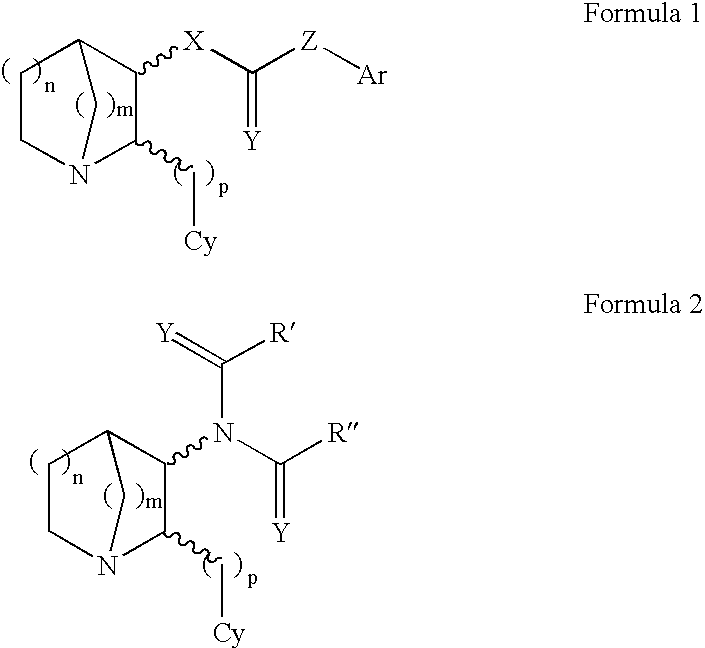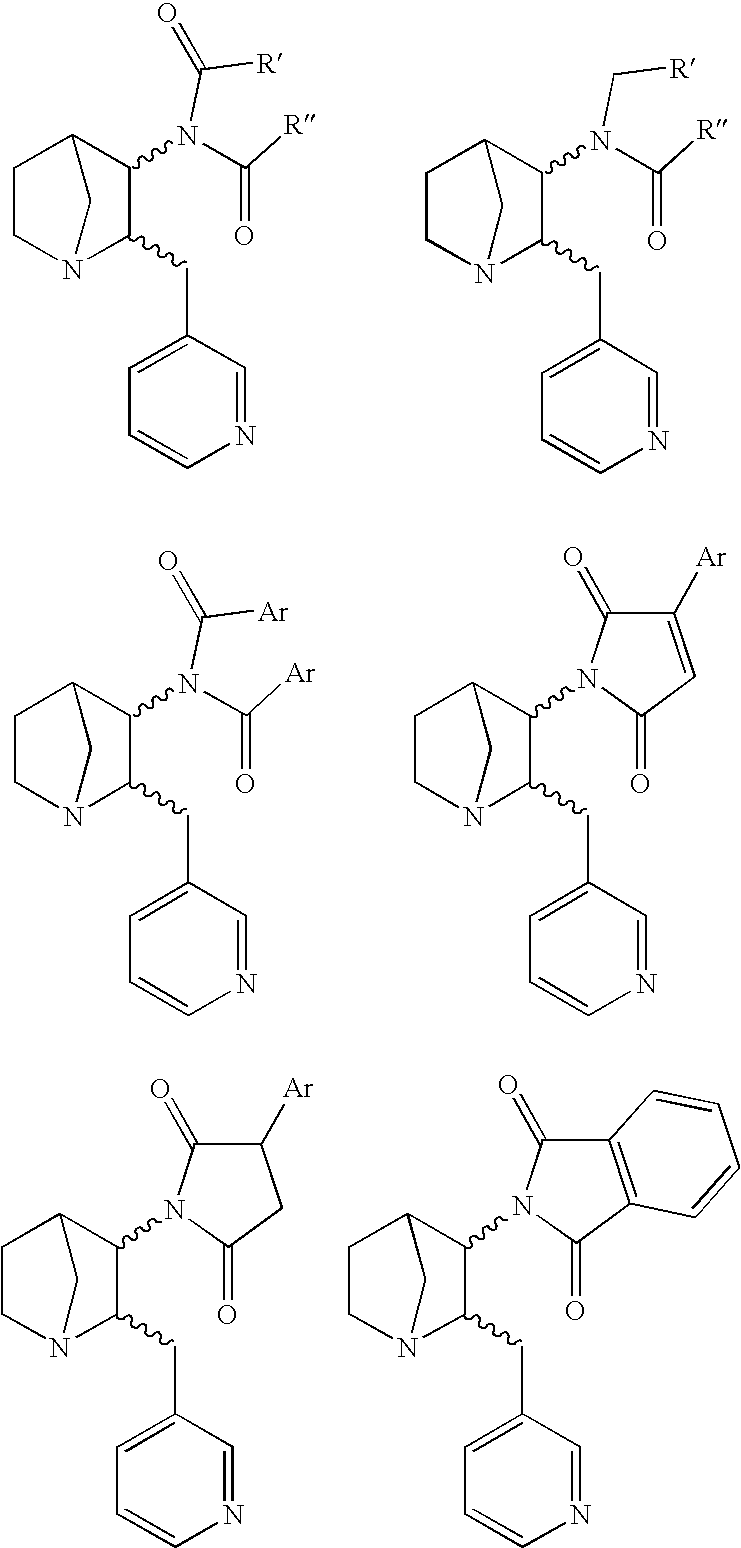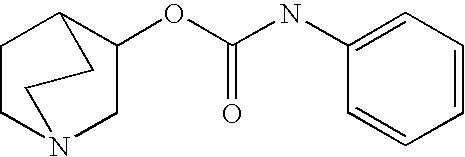3-Substituted-2(Arylalkyl)-1-Azabicycloalkanes and Methods of Use Thereof
a technology of azabicycloalkanes and substituents, which is applied in the field of pharmaceutical compositions, can solve the problems of not providing significant associated side effects, and achieve the effect of modulating activity, facilitating the release of ligands, and without appreciable side effects
- Summary
- Abstract
- Description
- Claims
- Application Information
AI Technical Summary
Benefits of technology
Problems solved by technology
Method used
Image
Examples
example 1
2-((3-Pyridinyl)methyl)-1-azabicyclo[2.2.2]oct-3-yl N-arylcarbamates
[0343] Various aryl isocyanates (0.2 mmol) were combined with 2-((3-pyridinyl)methyl)-1-azabicyclo[2.2.2]octan-3-ol (0.2 mmol) in anhydrous toluene (1 mL). The reaction mixtures were heated at 100° C. for 3 h and concentrated by centrifugal evaporation. The residues were dissolved in DMF (0.5 mL) and purified by HPLC on a C18 silica gel column, using acetonitrile / water gradients containing 0.05% trifluoroacetic acid as eluent. Compounds were isolated as trifluoroacetate salts and characterized by LCMS. All compounds exhibited appropriate molecular ions and fragmentation patterns. Those of 90% or greater purity were submitted for biological assessment. Selected compounds were analyzed by NMR spectroscopy, which confirmed their structural assignments.
TABLE 1LCMSCompoundCalc.Mass#Compound NameFB Mass(MH+)12-((3-pyridinyl)methyl)-1-416.321418.17azabicyclo[2.2.2]oct-3-yl N-(4-(81Br)bromophenyl)carbamate22-((3-pyridiny...
example 2
N-(2-((3-Pyridinyl)methyl)-1-azabicyclo[2.2.2]oct-3-yl)arylcarboxamides
[0346] Diphenylchlorophosphate (0.3 mmol) was added drop-wise to solutions of various arylcarboxylic acids (0.3 mmol) and triethylamine (0.3 mmol) in dry dichloromethane (1 mL). After stirring at ambient temperature for 1 h, a solution of 3-amino-2-((3-pyridinyl)methyl)-1-azabicyclo[2.2.2]octane (0.3 mmol) and triethylamine (0.6 mmol) in dry dichloromethane (0.5 mL) was added to each of the mixed anhydride solutions. The reaction mixtures were stirred overnight at ambient temperature, then diluted with chloroform (2 mL) and washed with 5 M NaOH (2 mL). The organic layers were concentrated under reduced pressure, and the residues were dissolved in methanol (0.5 ml) and purified by HPLC on a C18 silica gel column, using acetonitrile / water gradients containing 0.05% trifluoroacetic acid as eluent. Compounds were isolated as trifluoroacetate salts and characterized by LCMS. All compounds exhibited appropriate molecu...
example 3
N-Aryl-N′-(2-((3-Pyridinyl)methyl)-1-azabicyclo[2.2.2]oct-3-yl)ureas
[0349] Various arylisocyanates (0.3 mmol) were stirred with 3-amino-2-((3-pyridinyl)methyl)-1-azabicyclo[2.2.2]octane (0.3 mmol) in chloroform solution (1 mL) for 48 h at ambient temperature. The reaction mixtures were concentrated under reduced pressure, and the residues were dissolved in methanol (0.5 mL) and purified by HPLC on a C18 silica gel column, using acetonitrile / water gradients containing 0.05% trifluoroacetic acid as eluent. Compounds were isolated as trifluoroacetate salts and characterized by LCMS. All compounds exhibited appropriate molecular ions and fragmentation patterns. Those of 90% or greater purity were submitted for biological assessment. Selected compounds were analyzed by NMR spectroscopy, which confirmed their structural assignments.
[0350] Compounds possessing a methyl group on the nitrogen adjacent to the quinuclidine ring were prepared, by the same procedure as described above for unsu...
PUM
 Login to View More
Login to View More Abstract
Description
Claims
Application Information
 Login to View More
Login to View More - R&D
- Intellectual Property
- Life Sciences
- Materials
- Tech Scout
- Unparalleled Data Quality
- Higher Quality Content
- 60% Fewer Hallucinations
Browse by: Latest US Patents, China's latest patents, Technical Efficacy Thesaurus, Application Domain, Technology Topic, Popular Technical Reports.
© 2025 PatSnap. All rights reserved.Legal|Privacy policy|Modern Slavery Act Transparency Statement|Sitemap|About US| Contact US: help@patsnap.com



